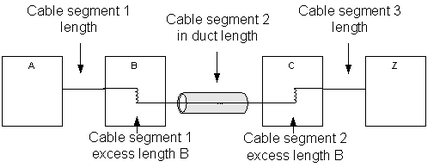Cable segments
Definition |
Cable segments represent sections into which the cable is fictively subdivided. A cable always consists of at least one cable segment. When creating a new cable, a cable segment is automatically created, which is identical to the cable. The cable may be subdivided by the user into further cable segments, where the following applies: •A cable segment lies between 2 locations A and B •A cable segment may start and end in a shaft/container. •A cable segment may lie between A and B in an Duct,
|
||||||||||||||||||||||||||||||||||||||||||
|
|
||||||||||||||||||||||||||||||||||||||||||
|
resulting in the following characteristics per segment:
|
Name |
The name of the segment is created automatically from “Cable name_Segment no”. It can be changed at any time.
|
Location A, Location B |
Are the two locations between which the cable segment is positioned. The A location of the first segment is the same as the A location of the cable. The B location of the last segment is the same as the Z location of the cable.
|
Shaft/Cable A, Shaft/Container B |
Are the two components of the category “Container/Cabinet” or “Shaft” between which the cable segment may lie; however, they must not be allocated. The definition is the same as the end components of the cable themselves. The Shaft/Container A of the first segment is the same as the A component of the cable. The Shaft/Container B of the last segment is the same as the Z component of the cable.
|
Duct |
Is a component of the category “Duct” in which the cable segment between Location A and Location B may lie.
|
Length |
The length describes the cable length between locations. This may be calculated based on the recorded parameterisation values. Amount(Parameterisation A – Parameterisation B)
|
Excess length A, B |
Excess lengths describe the cable lengths lying in Location A and/or Location B. The following applies to excess lengths: •The first cable segment may have excess lengths in Location A and Location B. •Every additional cable segment may only have excess lengths in Location B.
|
Cum. length[m] |
Cumulated length is automatically calculated from the sum of all lengths and excess lengths.
|
Effective length, geographic length |
For the cable itself, the following characteristics are automatically derived according to the definition of the cable segments with lengths and excess lengths: •Geographic length: corresponds to the cable length directly set between A and Z. It is automatically calculated from: Geographic length = S Segment lengths •Effective length: corresponds to the total length of the cable segments lying between A and Z. It is automatically calculated from: Effective Length = S Segment lengths + S Excess lengths
|

